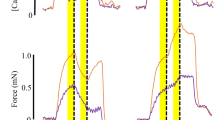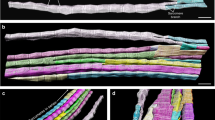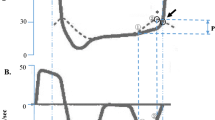Abstract
CARDIAC muscle has less strength in comparison with skeletal muscle. It has therefore been suggested that there may be fundamental differences in their processes of force generating1–3. While skeletal muscle can develop isometric forces ranging from 17 to 40 g/mm2 (refs. 4–9), maximum forces of only 2 to 7 g/mm2 are reported2,10–15 for heart muscle. Certain functional differences should be considered, however, before intrinsic differences in the mechanism of contraction of cardiac and skeletal muscle are suggested. Thus the lower isometric tension of cardiac muscle could result from any or all of the following: (1) cardiac muscle cannot be tetanized, and maximum force might be limited by the finite duration of active state during the twitch contraction2; (2) the contractile state of heart muscle is variable and generally less than maxima12,11, whereas the contractile state of skeletal muscle is essentially constant3; and (3) a large proportion of myocardium consists of non-contractile structures such as mitochondria and nuclei, unlike skeletal muscle16. It is not known whether correction for these factors would explain discrepancies in force development. Accordingly, the maximum contractile force of cardiac muscle has been examined during maximum potentiation of contractile state, and corrected for non-contractile muscle mass. These corrections permit more meaningful comparisons of the maximum capacity for contraction of cardiac and skeletal muscle.
This is a preview of subscription content, access via your institution
Access options
Subscribe to this journal
Receive 51 print issues and online access
$199.00 per year
only $3.90 per issue
Buy this article
- Purchase on Springer Link
- Instant access to full article PDF
Prices may be subject to local taxes which are calculated during checkout
Similar content being viewed by others
References
Huxley, H. E., Circulation Res. (suppl.), 24, 321 (1961).
Abbott, B. C., and Mommaerts, W. F. H. M., J. Gen. Physiol., 42, 533 (1959).
Abbott, B. C., and Wilkie, D. R., J. Physiol., 120, 214 (1953).
Wilkie, D. R., Prog. Biophys. Biochem., 4, 288 (1954).
Buchthal, F., Kaiser, E., and Rosenfalck, P., Biol. Meddr., 21, 1 (1951).
Hill, A. V., and Woledge, R. C., J. Physiol., 162, 311 (1962).
Aubert, X., Le Couplage Énergetique de la Contraction Musculaire (Arscia, Brussels, 1956).
Jewell, B. R., and Wilkie, D. R., J. Physiol., 143, 515 (1958).
Sexton, A. W., and Gersten, J. W., Science, 157, 199 (1967).
Lundin, G., Acta Physiol. Scand., Suppl. 20 (1944).
Sonnenblick, E. H., Amer. J. Physiol., 202, 931 (1962).
Ullrich, W. C., Amer. J. Physiol., 206, 1285 (1964).
Brady, A. J., Fed. Proc., 24, 1410 (1965).
Koch-Weser, J., Amer. J. Physiol., 204, 451 (1963).
Fisher, V. J., Lee, R. J., Marlon, A. M., and Kaveler, F., Circulation Res., 20, 520 (1967).
Spiro, D., and Sonnenblick, E. H., Circulation Res., 15, 14, Suppl. 2 (1964).
Hoffman, B. F., Bartlestone, H. J., Scherlag, B. J., and Cranefield, P. F., Bull. NY Acad. Med., 41, 498 (1965).
Sonnenblick, E. H., Frommer, P. L., and Braunwald, E., Bull. NY Acad. Med., 41, 554 (1965).
Fisher, V. J., Lee, R. J., Marlon, A. M., and Kaveler, F., Circulation Res., 20, 520 (1967).
Sonnenblick, E. H., Spiro, D., and Cottrell, T., Proc. US Nat. Acad. Sci., 40, 1931 (1963).
Bärany, M., Bärany, K., Reckard, T., and Volpe, A., Arch. Biochem. Biophys., 109, 185 (1965).
Katz, A. M., Repke, D. I., and Rubin, B. B., Circulation Res., 19, 611 (1966).
Chandler, B. M., Sonnenblick, E. H., and Pool, P. E., Circulation Res., 21, 717 (1967).
Author information
Authors and Affiliations
Rights and permissions
About this article
Cite this article
SONNENBLICK, E., PARMLEY, W., BUCCINO, R. et al. Maximum Force Development in Cardiac Muscle. Nature 219, 1056–1058 (1968). https://doi.org/10.1038/2191056a0
Received:
Revised:
Issue Date:
DOI: https://doi.org/10.1038/2191056a0
This article is cited by
-
On the mechanism of elevation of cardiac muscle functional capabilities in adaptation to exercise
Basic Research in Cardiology (1980)
Comments
By submitting a comment you agree to abide by our Terms and Community Guidelines. If you find something abusive or that does not comply with our terms or guidelines please flag it as inappropriate.



